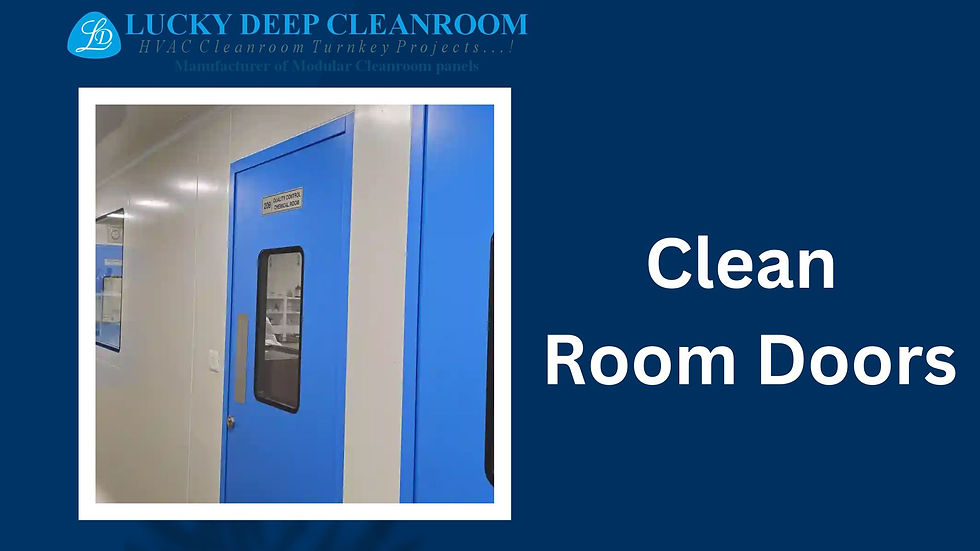Premium Clean Room Doors by Leading Manufacturers: Engineered for Precision and Performance
- Lucky Deep
- Jul 28
- 3 min read
In critical environments such as pharmaceutical manufacturing, biotechnology labs, healthcare facilities, and electronics assembly units, maintaining sterility, hygiene, and air pressure differentials is paramount. This is where clean room doors manufacturers play a pivotal role—delivering purpose-built solutions tailored for cleanroom performance, safety, and longevity.
Clean Room Doors are more than just entryways; they are integral components of the controlled environment architecture. Designed with precision, these doors are engineered to provide robust sealing, minimize contamination risks, and ensure smooth functionality under strict operational protocols.
Engineered for Excellence: Construction and Materials
One of the distinguishing features of clean room doors manufactured by reputed brands is their double-skin construction, which ensures structural integrity and thermal insulation. These doors are designed to align seamlessly with modular wall panels, maintaining the continuity of the cleanroom envelope.
The material of construction includes high-quality GPSP GI Sheets—0.8 mm thick for standard doors and 1.2 mm thick for fire-rated doors—ensuring strength and compliance with fire safety norms. The frame thickness is typically 1.2 mm for standard models and up to 1.6 mm for enhanced fire resistance.
The shutter thickness is available in 42 mm, 44 mm, or 46 mm options, depending on the required application. These doors are finished using durable powder coating with a thickness of 60 to 80 microns, or in select applications, stainless steel for enhanced corrosion resistance and hygiene compliance.
Versatile Sizes and Filler Options
Clean room doors come in multiple standard thicknesses—50mm, 80mm, 100mm, and 150mm—offering flexibility to suit different cleanroom classifications and design parameters. Door widths range from 750 mm to 2200 mm, accommodating single-leaf and double-leaf configurations.
To meet specific thermal and acoustic insulation needs, door shutters are filled with high-density materials like:
PUF (Polyurethane Foam): 40±2 kg/m³
PIR (Polyisocyanurate): 48±2 kg/m³
Rockwool: 96±2 kg/m³
Each infill material is selected for its unique properties—PUF and PIR for thermal efficiency, and Rockwool for superior fire resistance and sound absorption.
Thoughtfully Designed Accessories for Functionality & Safety
Cleanroom operations demand seamless accessibility and stringent hygiene. To support this, top clean room doors manufacturers equip their products with premium-grade accessories such as:
Stainless steel hinges (3 to 4 per door) for strength and smooth operation
Stainless steel “D” type handles (20 mm dia. x 300 mm long) for ergonomic grip
Push plates and kick plates to reduce contact contamination
Dorma TS-68 door closers with standard arms for controlled self-closing
Automatic door bottom seals to prevent air leakage
View panels with 6 mm thick safety glass for visibility without compromising containment
Panic bars for emergency exit doors
Flush tower bolts in double door systems
Door interlocking systems to maintain air pressure and reduce cross-contamination
These accessories are not just add-ons—they are part of a comprehensive system designed to ensure safety, efficiency, and compliance in cleanroom environments.
The Role of Clean Room Doors in Contamination Control
The effectiveness of a cleanroom depends not just on air filtration and pressure control, but also on how well the space is sealed. Doors are a major leakage point if not properly designed. High-performance clean room doors with airtight sealing mechanisms significantly reduce particle transfer and maintain controlled air environments.
Furthermore, the robust powder coating and stainless steel finish allow for easy cleaning and resistance to disinfectants, which is vital in environments that demand frequent sanitation.
Why Choose Trusted Clean Room Doors Manufacturers?
Leading clean room doors manufacturers bring years of experience, precision engineering, and innovation to every product. Their expertise ensures doors that not only meet international cleanroom standards but are also tailored to industry-specific requirements—from pharma-grade finishes to electronic static discharge control.
When you choose a trusted manufacturer, you're not just purchasing a door—you’re investing in compliance, performance, and long-term value.
Conclusion
Clean room doors are a fundamental component of controlled environments, designed to meet the most rigorous standards of cleanliness, insulation, and operational efficiency. With superior materials like GPSP GI Sheets, stainless steel finishes, intelligent door hardware, and infill options like PUF, PIR, and Rockwool, these doors are engineered for long-term durability and contamination control.
If you’re planning a cleanroom facility or upgrading your current infrastructure, partnering with leading clean room doors manufacturers ensures that every detail is handled with precision—from dimensions to performance, from hygiene to fire safety.





Comments